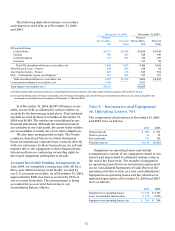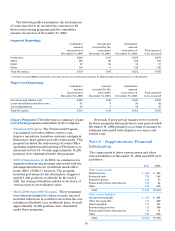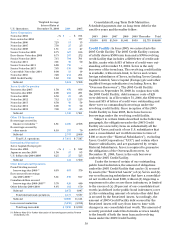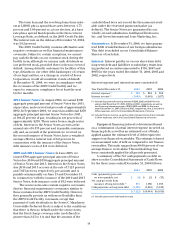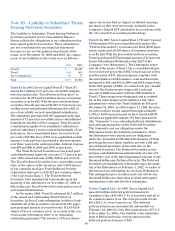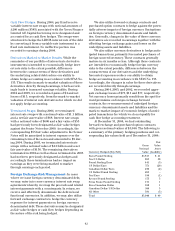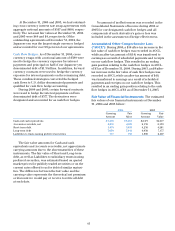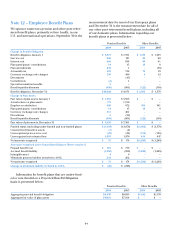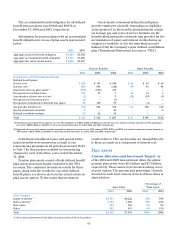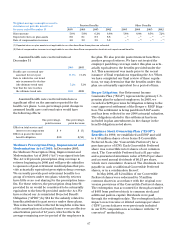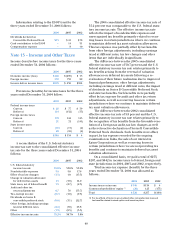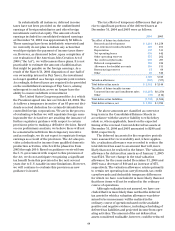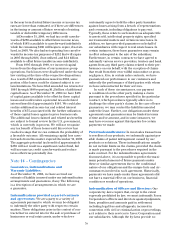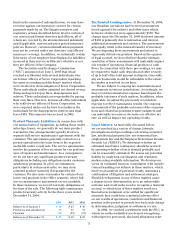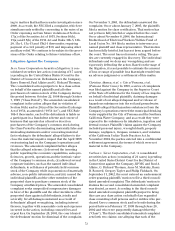Xerox 2004 Annual Report Download - page 64
Download and view the complete annual report
Please find page 64 of the 2004 Xerox annual report below. You can navigate through the pages in the report by either clicking on the pages listed below, or by using the keyword search tool below to find specific information within the annual report.
62
Cash Flow Hedges: During 2004, pay fixed/receive
variable interest rate swaps with notional amounts of
£200 million ($385) associated with the Xerox Finance
Limited GE Capital borrowing were designated and
accounted for as cash flow hedges. The swaps were
structured to hedge the LIBOR interest rate of the debt
by converting it from a variable rate instrument to a
fixed rate instrument. No ineffective portion was
recorded to earnings during 2004.
Derivatives Marked-to-Market Results: While the
remainder of our portfolio of interest rate derivative
instruments is intended to economically hedge inter-
est rate risks to the extent possible, differences
between the contract terms of these derivatives and
the underlying related debt reduce our ability to
obtain hedge accounting in accordance with SFAS No.
133. This results in mark-to-market valuation of these
derivatives directly through earnings, which accord-
ingly leads to increased earnings volatility.During
2004 and 2003, we recorded net gains of $4 and net
losses of $13, respectively, from the mark-to-market
valuation of interest rate derivatives for which we did
not apply hedge accounting.
Terminated Swaps: During 2004, we terminated
interest rate swaps with a notional value of $1.1 billion
and a net fair asset value of $68. Interest rate swaps
with a notional value of $600 and a fair value of $55
had previously been designated as fair value hedges
against the Senior Notes due 2009. Accordingly, the
corresponding $55 fair value adjustment to the Senior
Notes will be amortized to interest expense over the
remaining term of the notes and amounted to $9 dur-
ing 2004. During 2003, we terminated interest rate
swaps with a notional value of $2.0 billion and a net
fair asset value of $136. The remaining derivatives
terminated in 2004 as well as those terminated in 2003
had not been previously designated as hedges and
accordingly those terminations had no impact on
earnings as they were being marked to market
through earnings each period.
Foreign Exchange Risk Management: In cases
where we issue foreign currency denominated debt,
we may enter into cross-currency interest rate swap
agreements whereby we swap the proceeds and related
interest payments with a counterparty. In return, we
receive and effectively denominate the debt in local
functional currencies. In addition, we may also utilize
forward exchange contracts to hedge the currency
exposure for interest payments on foreign currency
denominated debt. These derivatives may be designated
as fair value hedges or cash flow hedges depending on
the nature of the risk being hedged.
We also utilize forward exchange contracts and
purchased option contracts to hedge against the poten-
tially adverse impacts of foreign currency fluctuations
on foreign currency denominated assets and liabili-
ties. Generally, changes in the value of these currency
derivatives are recorded in earnings together with the
offsetting foreign exchange gains and losses on the
underlying assets and liabilities.
We also utilize currency derivatives to hedge antic-
ipated transactions, primarily forecasted purchases of
foreign-sourced inventory. These contracts generally
mature in six months or less. Although these contracts
are intended to economically hedge foreign currency
risks to the extent possible, differences between the
contract terms of our derivatives and the underlying
forecasted exposures reduce our ability to obtain
hedge accounting in accordance with SFAS No. 133.
Accordingly, the changes in value for these derivatives
are recorded directly through earnings.
During 2004, 2003, and 2002, we recorded aggre-
gate exchange losses of $73, $11 and $77, respectively.
Net currency losses primarily result from the spot/for-
ward premiums on foreign exchange forward
contracts, the re-measurement of unhedged foreign
currency-denominated assets and liabilities and the
mark-to-market impact of economic hedges of antici-
pated transactions for which wedo not qualify for
cash flowhedge accounting treatment.
At December 31, 2004, we had outstanding
forward exchange and purchased option contracts
with gross notional values of $5,040. The following is
asummary of the primary hedging positions and cor-
responding fair values held as of December 31, 2004:
Fair
Gross Value
Notional Asset
Currency Hedged (Buy/Sell) Value (Liability)
Euro/Pound Sterling $1,817 $ 41
Yen/US Dollar 895 38
Pound Sterling/Euro 441 (5)
US Dollar/Euro 371 (29)
Canadian Dollar/Euro 230 (2)
US Dollar/Pound Sterling 203 —
Yen/Euro 190 (1)
Kronor/Pound Sterling 173 3
Swiss Franc/Pound Sterling 131 1
Euro/Canadian Dollar 108 1
Canadian Dollar/US Dollar 100 5
All Other 381 (3)
Total $5,040 $ 49


